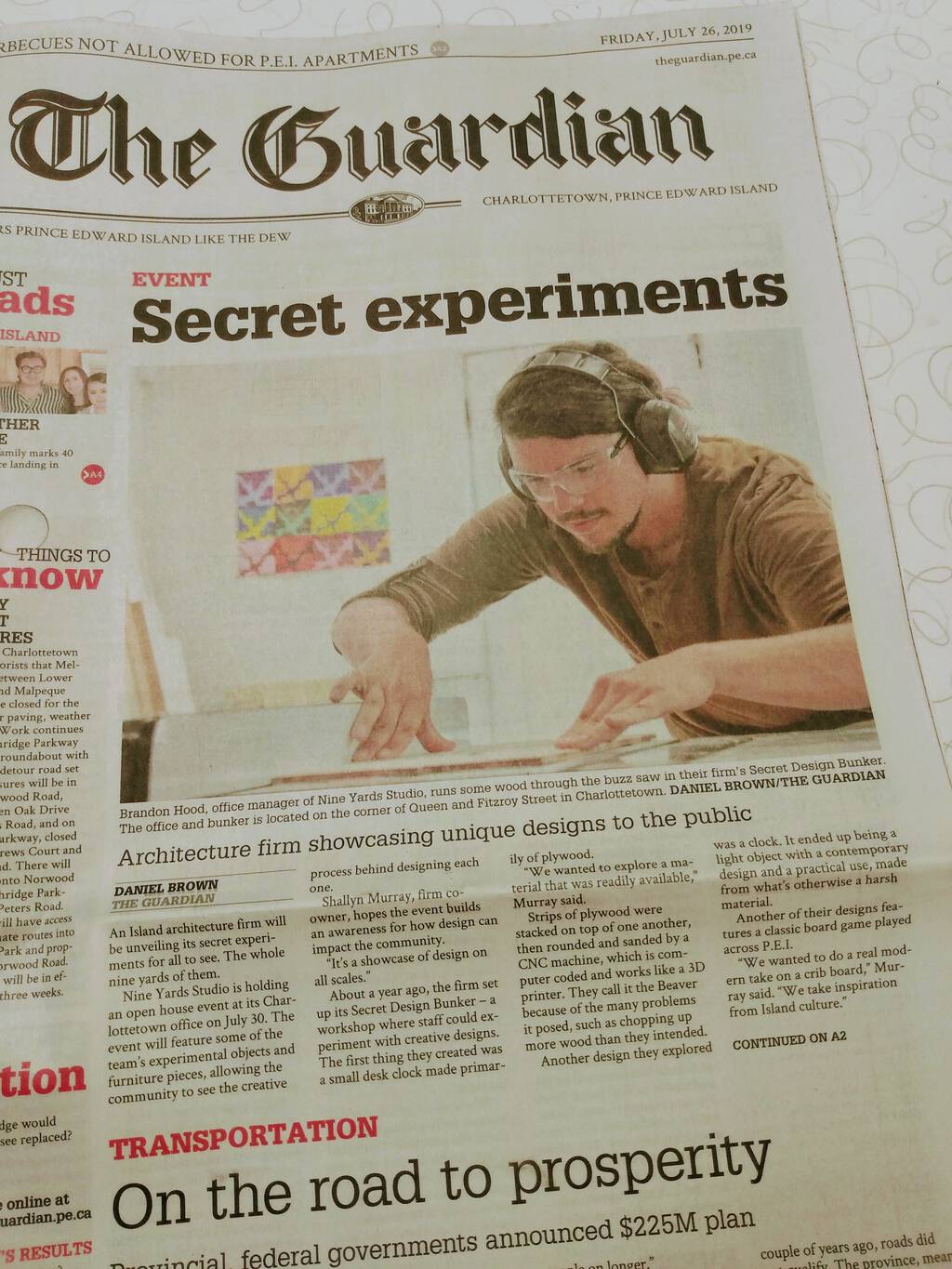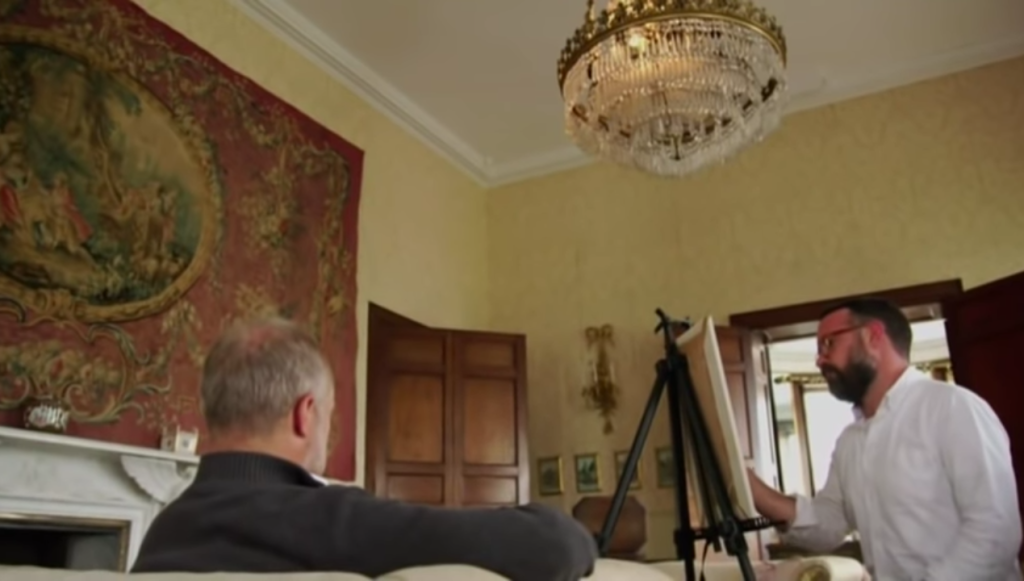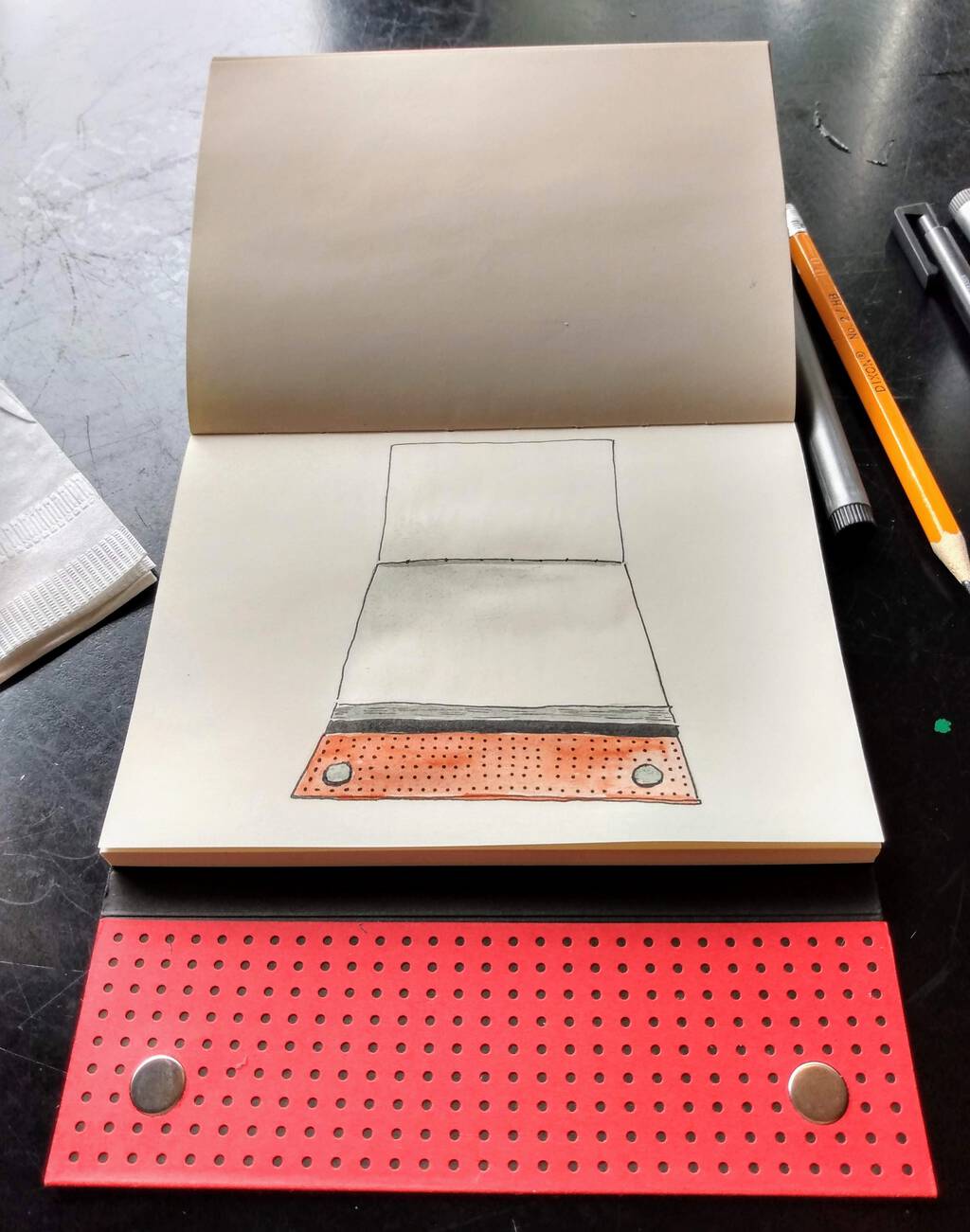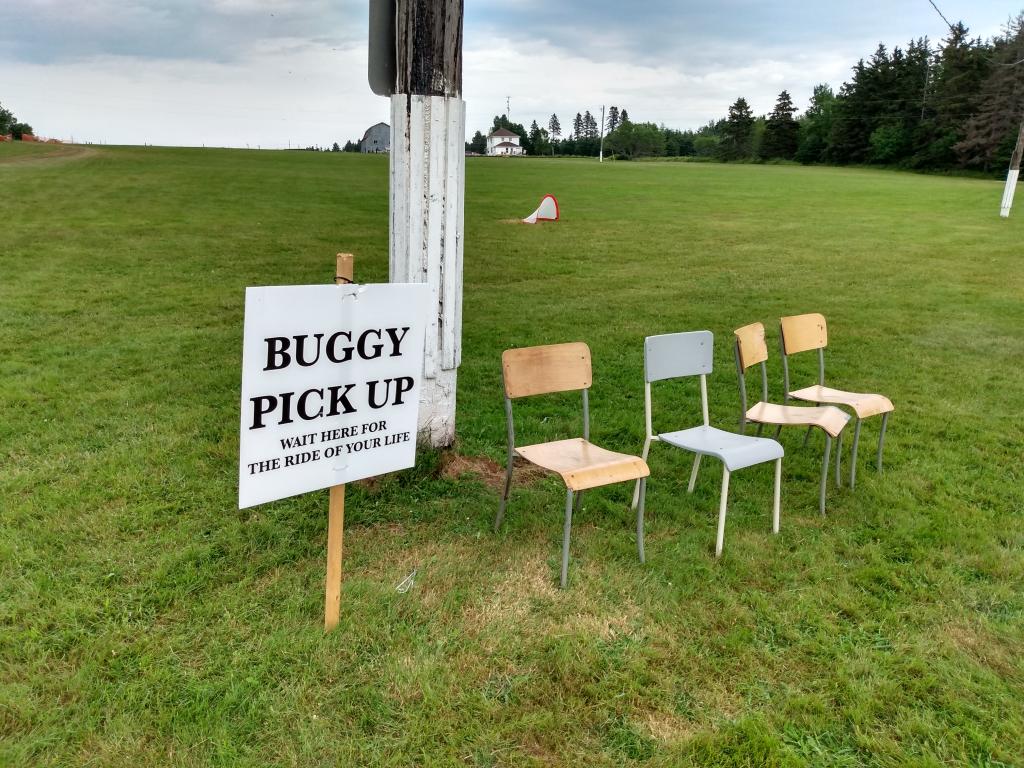A lovely new video from The East Pointers, featuring Emma Watkins, aka Emma Wiggle.
And, in the other direction, The Wiggles ft. Tim Chaisson of The East Pointers.
Let us never forget that Steven Garrity broke Tim Chaisson 15 years ago. It’s been a meteoric rise ever since.
The first Pride Parade happened in Charlottetown in 1994, the summer after we arrived on Prince Edward Island. It was a shameful event, not for the parade itself, but for the insults and objects hurled from the sidewalks at the brave who ventured out.
Twenty-five years and one 18 year old son later, Pride was a very different thing today: a joyful celebration that stretched for miles and included as diverse a group as I’ve ever seen.
Among those participating was Oliver, who joined with the Green Party on its solar bicycle float; you can see him pedaling his heart out as he passed me on Euston Street this afternoon (he’s in a green T-shirt on the end of the bike, wearing a grey cap):
I am both a proud father, and proud of this Island for having evolved over the last 25 years.
My friends at Nine Yards Studio have been skunkworking away for months now, inside a sonically-isolated design shop floating inside the courtyard of their headquarters on Fitzroy Street, on a project that seeks to take their considerable skills dealing with Big Things into the world of Small Things.
When they gave me an early tour this winter, I casually referred to the effort, in my affected way, as taking place in their “secret design bunker.”
This week I was overjoyed to receive an invitation to the public launch of the… Secret Design Bunker.
Finally, after years of vain frustration, toiling in the mines of coming up with names for things (here, here), I hit the big time!
There’s a blog post (emphasis mine, obviously):
Stacked, is the Secret Design Bunker’s first series of design explorations. The series celebrates plywood as a material and experiments with the potential forms it can be used to create. Children curiously stack wood blocks on top of one another; the Secret Design Bunker explored the potential forms of plywood could create with the same sense of curiosity.
And an invite:

And a front page story in The Guardian this morning:

The hatch to the Secret Design Bunker gets opened to public air on Tuesday, July 30, 2019 at 12 noon at 63 Fitzroy Street in Charlottetown.
On a Monday afternoon in May 1998, Keith Milligan, Leader of the Official Opposition on Prince Edward Island, was playing golf at the Mill River Golf Course, up west.
The Guardian picks up the story from there in its May 20, 1998 edition (emphasis mine):
Had Keith Milligan been further along in his golf game when he was stricken by a massive heart attack Monday afternoon, he might not have lived long enough to see the emergency room at Community Hospital in O’Leary.
“We were lucky,” Liberal MLA Hector MacLeod said Tuesday.
MacLeod was with Milligan at the Mill River resort when the Liberal leader’s heart attack hit on the second hole.
“We were joking back and forth about the game, the way we always do. I only knew there was something wrong when I saw a couple of the people we were golfing with putting him into the cart and running him back to the parking lot. If we’d been further out it could have been very bad.”
As it was, Milligan required electrical defibrillation to get his heart restarted when he arrived at the Community Hospital in O’Leary.
Dr. Herb Dickieson, leader of the Island New Democrats, was the doctor on call at Community Hospital when Milligan arrived.
Milligan was leader of the Liberal Party, Dickieson of the NDP: that one should save the life of the other is a uniquely Prince Edward Island story; surprising, but not that surprising.
I thought of that episode, 21 years ago, when I read a story today, also in The Guardian, about ministerial disclosure statements: it turns out that Hon. Brad Trivers, Minister of Environment, Water and Climate Change, is a shareholder in Solar Island Electric, an enterprise of which Green Party MLA Steve Howard, and Shadow Critic for Transportation, Infrastructure, and Energy, is President.
Trivers laid out the details of the relationship on his blog three years ago, when he was in opposition; in part:
Last year when I was reading this article about the future of energy it got me excited about solar again, so I looked into what might be available on Prince Edward Island. Incidentally some version of these two statements from that article (on the Wait But Why site) is what I would like to see as the base of the PEI Energy Strategy:
1) We need almost everything we use to be running on electricity.
2) We need almost all of our electricity to be produced from sustainable sources.
My research led me to a company founded by Islander Steve Howard called Renewable Lifestyles. This company promised to source and install PV solar panels that are guaranteed for 25 years, and should last 40 years, with almost no maintenance. But, more importantly, it can be done with a reasonable payback period for my investment – I wouldn’t have to wait 20 years after they were installed to start actually making money on the investment. This seemed almost too good to be true. So I set up a meeting with Steve Howard to try to understand how this could be. I soon found out that the PV solar panels themselves, although cheaper than in the past, were still fairly expensive – but in the absence of any straight-forward government incentives he had figured out a way to use existing programs to make it affordable.
First off, how great is it that the Minister of Climate Change has a long-term interest in solar energy, has a blog, and has used that blog to describe, in commendable detail, what steps his family took to install solar generation capacity.
Second off, how great is it that the Shadow Critic for Transportation, Infrastructure, and Energy owns a solar energy company.
And, finally, how great is it that the two have a pre-existing relationship around solar energy and are now part of a collaborative Legislative Assembly.
If good things cannot come from this alignment of stars, I don’t know when they will.
The latest season of Jerry Seinfeld’s Comedians in Cars Getting Coffee includes an episode featuring Martin Short.
In addition to learning that Short is friends with Carol Pope, I was reminded of the SCTV bit Martin Scorcese’s Jerry Lewis Live on the Champs Elysees, a title that pretty well sums of the brilliance of that show.

Oliver and I have settled into a comfortable pattern of taking the bus home from Stars for Life every weekday afternoon: I catch the 3:45 p.m. bus up, and we catch the 4:30 p.m. bus back.
The Route № 2 bus, which I catch up to Stars for Life, is frequently late, but generally only by a few minutes.
Today, though, there was a chain reaction that caused a longer delay than is usual: we hit the Wall of Public Servants leaving Charlottetown out North River Road.
In the normal course of affairs it’s smooth sailing for Route № 2, as there’s little traffic on North River Road at 3:48 p.m. Tack on a 5 or 6 minute delay, however, and suddenly it’s quitting time downtown for a glut of provincial and federal public servants, and North River Road fills up from Kirkwood Drive to Capital Drive and then inches along. Which delays the bus even more.
The irony here is that if more public servants took the bus, the bus wouldn’t be late. So more public servants would take the bus.
Chain reactions work in two directions.
I quite enjoyed this television program about the painting of a portrait of Graham Norton. Both subject and painter are interesting people and Norton especially is so much more textured than his typical television persona.

In January 2018 I replaced my venerable Marimekko Cash & Carry Shoulder Bag with a Bolstr EDC bag.
The Bolstr has much to recommend it, and I happily carried it on my shoulder for over a year.
Until this spring when the magnetic closure on the front flap separated from the bag.
As I store my mobile phone under that front flap. having it flap around was untenable, and I had to pull the Marimekko out of retirement until I could have the Bolstr repaired.
The nub of the issue–literally–was this clasp:

This piece was attached to the flap; it’s actually two parts that screw into each other, with a piece of fabric–a piece of fabric that ended up giving way–sandwiched between them.
I didn’t know that they screwed together, and it wasn’t until I learned this today, via email from Bolstr HQ, that I realized that I could probably fix the problem myself.
What it came down to was needing to bolster (ha!) the flap to better accommodate the clasp; for this I used a two squares of leather originally acquired to make a brake for my letterpress.
On the inside of the flap the repair looks like this (I used orange cotton twine that I purchased from The Bookmark earlier this year to do the sewing); you can see the female side of the magnetic clasp under the flap.

On the other side of the flap the only evidence of the fix is some bright orange stitching (I tucked the other half of the “leather sandwich” inside the flap rather than on the outside:

The fix is satisfyingly sturdy, and I’ve put the Marimekko back into storage and started carrying the Bolstr again.
I used the opportunity to resurrect my watercolour sketching practice; the Marimekko didn’t have room for my portable watercolour set nor my water brush, and so I’d been sketching only in black and white and grey for several months.
It’s nice to have the colours of the rainbow back at my disposal. I marked the occasion by sketching my sketchbook.

My family spent the summer of 1969, as we did most summers in the late 1960s and early 1970s, “in the field” with my father. His work as a nearshore sedimentologist, with a particular interest the Great Lakes, meant that each summer we would decamp to a new location on Lake Ontario, or Lake Erie, or Lake Huron, generally to a provincial park. I remember those summers for their park rangers and salamanders and beaches and forests and tents and trailers.
On July 20, 1969—fifty years ago today—we were, by my mother’s recollection, on the shore of Lake Ontario near Cobourg. My father’s log from that day picks up the story:
Retired around 7 PM with the small TV set and watched moon walking using a VW battery and converter.
While I have memories before July 20, 1969, none are as crystal clear and vivid as that one: the family gathered around a tiny TV set, the picture–perhaps because it was running off a VW battery–smaller than it was supposed to be. I’m not sure I was old enough, at three, to comprehend the enormity of what was happening, but I’m certain that I picked up on my parents’ excitement. And, of course, that we were allowed to stay up much, much later than usual.
According to my parents, there were no family photos taken on that particular day, but here are some that my mother sent of me and brother Mike (just two years old himself) and our father in that summer of 1969.

My next palpable memories, at least those involving the USA and television, were of the daily updates from Vietnam, and then of Nixon resigning.
But, man, that night in July 1969 was pretty amazing.

 I am
I am